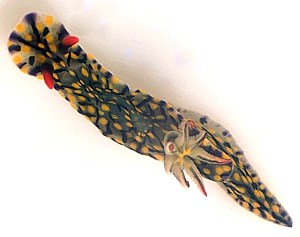

Hypselodoris kanga
Rudman, 1977
Order: NUDIBRANCHIA
Suborder: DORIDINA
Family: Chromodorididae
DISTRIBUTION
From the western Indian Ocean to Hong Kong.
PHOTO
UPPER: Kunduchi Beach, Dar es salaam, Tanzania, July, 1973, 42mm long. PHOTO: Bill Rudman.
LOWER: Round Is, Hong Kong, November 1982, with egg mass. PHOTO: B.W. Darvell. Inset showing characteristic yellow spots on outside face of gills.
Hypselodoris kanga is one of a number of species with a bluish background colour, short dark blue lines and yellow or orange spots. Some specimens are very similar in colour to Hypselodoris infucata. One of the most distinctive external characters is the triangular gills, edged in blue with a series of yellow spots up the outer face.
Other species with black lines include Hypselodoris nigrolineata, Hypselodoris maritima and Hypselodoris nigrostriata.
Reference:
• Rudman, W.B. (1977) Chromodorid opisthobranch Mollusca from East Africa and the tropical West Pacific. Zoological Journal of the Linnean Society, 61: 351-397.
Rudman, W.B., 1999 (February 8) Hypselodoris kanga Rudman, 1977. [In] Sea Slug Forum. Australian Museum, Sydney. Available from http://www.seaslugforum.net/find/hypskang
Related messages
Hypselodoris kanga from Andaman Islands
December 14, 2009
From: CR Sreeraj
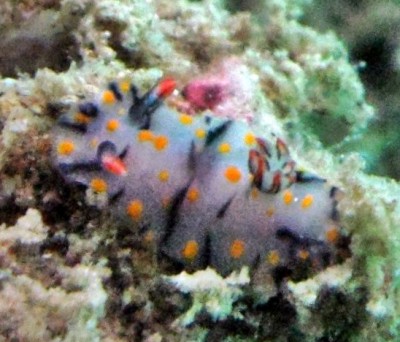
Sir,
here is a record of Hypselodoris zebrina from Andaman Islands.
Locality: Ritchies Archipelago, Andaman and Nicobar Islands, Andaman Sea, Indian Ocean, 02 june 2009. Photographer: Vikas, Dive India.
Regards
CR
crsreeraj@gmail.com
Sreeraj, C.R., 2009 (Dec 14) Hypselodoris kanga from Andaman Islands. [Message in] Sea Slug Forum. Australian Museum, Sydney. Available from http://www.seaslugforum.net/find/22963Dear CR,
Although it has similarities to H. zebrina your animal is a colour form of Hypselodoris kanga. We have a very similarly coloured animal from Thailand [message #19548] on the Forum. Both the gills and rhinophores in your animal are bluish with red tips, which is often found in H. kanga
Best wishes,
Bill Rudman
Hypselodoris kanga from Indonesia
March 3, 2008
From: Sandrine Templin

Concerning message #4169:
Could you confirm me it's Hypselodoris obscura. This photo was taken at Lembeh Strait, Indonesia.
And for your collection, Glossodoris cincta taken by my friend Benoit, Lembeh.
Thank you.
Sandrine Templin
sand.temp@orange.fr
Templin, S., 2008 (Mar 3) Hypselodoris kanga from Indonesia. [Message in] Sea Slug Forum. Australian Museum, Sydney. Available from http://www.seaslugforum.net/find/21411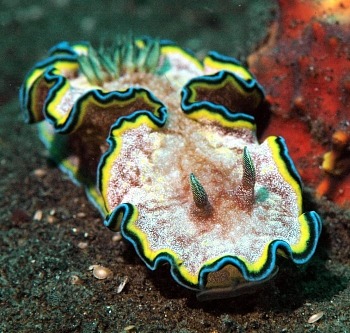
Dear Sandrine,
The animal in your upper photo looks quite like H. obscura and H. infucata but the gills are clearly triangular in cross section, which is fdifferent from both those species, and they have yellow spots on the outer face, which is a clear character of H. kanga.
Thanks for the photo of G. cincta. Before you send any further messages to the Forum, could you please have a look at the instructions. I don't want the Forum to be just a one-way street where I identify photos and that's that. I want it to a two-way exchange where I answer questions in exchange for a little bit of data which might be valuable in future to someone doing some research. That is why I ask for some basic locality and specimen data and ask that participants put different species into separate messages so they can be filed away sensibly for future recall. Most participants are happy to work on this basis.
Best wishes,
Bill Rudman
Re: Hypselodoris kanga from Lembeh, Indonesia
September 28, 2007
From: Kamal El Tawil

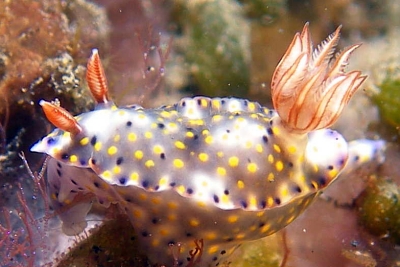
Concerning message #20778:
Dear Bill,
I've been meaning to post a message with the attached picture for sometime now but I have had difficulty identifying the species. Thanks to the Forum ! With the triangular shaped gills though missing the yellow or white spots, can we conclude that this animal is also a Hypselodoris kanga? It seems to be feeding on a white substrate which is not too clear in my picture.
Locality: Lembeh Straight, N.E. Sulawesi, 10 meters, Indonesia, Celebes sea, 12 August 2007. Length: 25-30mm. Photographer: Kamal El Tawil.
Kindest regards,
Kamal El Tawil
www.coralworld.net
kamal@coralworld.net
El Tawil, K., 2007 (Sep 28) Re: Hypselodoris kanga from Lembeh, Indonesia. [Message in] Sea Slug Forum. Australian Museum, Sydney. Available from http://www.seaslugforum.net/find/20837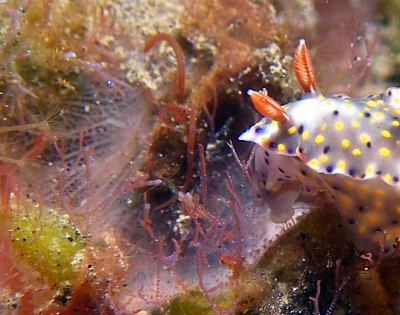
Dear Kamal,
Yes I would identify this as H. kanga. We have quite a group of photos of this species on the Forum now and you can see an almost continuous series of photos from ones showing your 'spotless gills' form to ones with the 'typical' spotted gills.
I am certain it is feeding on the bluish? pinkish? sponge right in front of it. I think the white patch the extended oral tube is attached to, or reaching towards, is part of the sponge. From the network pattern of sponge fibres I can see I am pretty sure this is the species of Dysidea, probably unnamed, on which we have seen H. kanga feeding before.
Best wishes,
Bill Rudman
Hypselodoris kanga from Indonesia [2]
September 27, 2007
From: Francois Zylberman

Dear Bill,
I photographed this nudibranch in the Lembeh Strait. I think that it makes party of the Chromodorid family. Can you help me to identify it?
Locality: Lambeh strait, 15 m, Indonesia, North Sulawesi, Indopacific, 30 april 2006, Muck. Length: 50-70 mm. Photographer: Francois Zylberman
Many Thanks
Francois
francois@geodia.com
Zylberman, F., 2007 (Sep 27) Hypselodoris kanga from Indonesia [2]. [Message in] Sea Slug Forum. Australian Museum, Sydney. Available from http://www.seaslugforum.net/find/20765Dear Francois,
I am pretty sure this is Hypselodoris kanga. The spots on the outer face of each gill are not as clear as in your other message [#20778] but there is a double orange line which indicates the gills are traingular in cross-section. Now and then there are specimens in which the spots are not easy to see.
Best wishes,
Bill Rudman
Hypselodoris kanga from Lembeh, Indonesia
September 27, 2007
From: Francois Zylberman

Dear Bill,
Here a request for identification for this nudibranch photographed still in the Lambeh Strait, definitely an enormous resource of diversity!
I think that it is Hypselodoris, but which?
Locality: Lembeh Strait, Indonesia, Indo pacific, 28 April 2006, muck dive. Length: about 70 mm. Photographer: Francois Zylberman.
Best wishes
François Zylberman
www.geodia.com
francois@geodia.com
Zylberman, F., 2007 (Sep 27) Hypselodoris kanga from Lembeh, Indonesia. [Message in] Sea Slug Forum. Australian Museum, Sydney. Available from http://www.seaslugforum.net/find/20778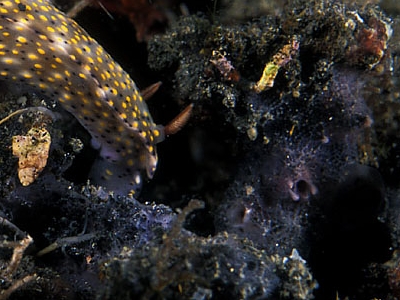
Dear Francois,
This is Hypselodoris kanga. It can be distinguished from similarly coloured species such as H. infucata by the shape and colour of the gills. If you look carefully, the gills of H. kanga are triangular in cross-section and there are white or yellow spots on the smooth outer edge of each gill. This animal is feeding on the dark blue sponge. The extended oral tube of the animal is clearly visible. The sponge is almost certainly a species of Dysidea, and probably the same species as H. nigrostriata is eating in your message #20766.
Best wishes,
Bill Rudman
Hypselodoris kanga laying eggs
August 23, 2007
From: Carlos Munda
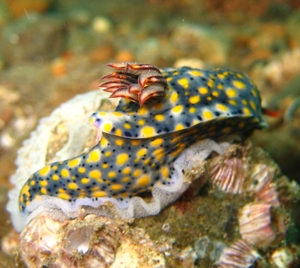
For your file: Hypselodoris infucata (?) laying eggs
Locality: Mainit Bubbles Beach, 10-12 meters, Batangas, Philippines, Pacific Ocean, June 2007, Sandy beach. Length: 1.5 - 2 inches. Photographer: Carlos R. Munda, Jr..
Carlos R. Munda
c_munda@yahoo.com
Munda, C., 2007 (Aug 23) Hypselodoris kanga laying eggs. [Message in] Sea Slug Forum. Australian Museum, Sydney. Available from http://www.seaslugforum.net/find/20259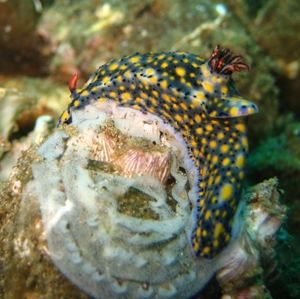
Thanks Carlos,
I can't see the gills too clearly, but I am pretty sure this is H. kanga.
Bill Rudman
Rudman, W.B., 2007 (Aug 23). Comment on Hypselodoris kanga laying eggs by Carlos Munda. [Message in] Sea Slug Forum. Australian Museum, Sydney. Available from http://www.seaslugforum.net/find/20259Hypselodoris kanga feeding in the Philippines
August 7, 2007
From: Mike Krampf

Thought I share this series of photos which I assume shows this Hypselodoris kanga extending its mouth.
Locality: Puerto Galera, 40 ft, Mindoro Island, Phillipines, Batangas Sea, 22 February 2007, Fringing reef. Length: 3 cm. Photographer: Mike Krampf.
Cheers,
Mike
mtkrampf@yahoo.com
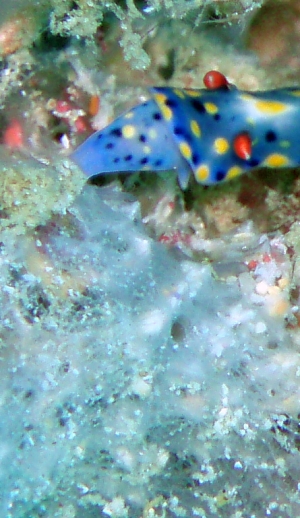
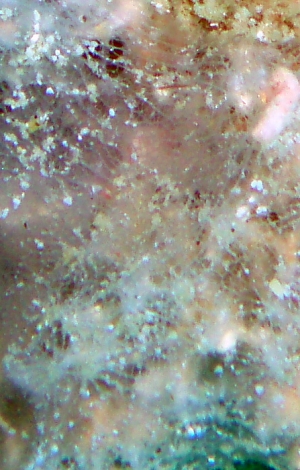
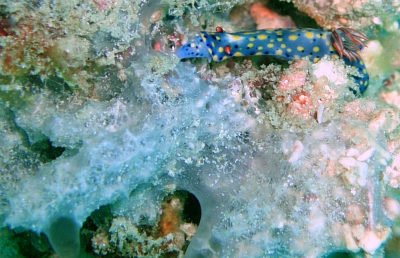
Dear Mike,
Thanks for these photos. Yes its is H. kanga feeding on its favourite species of Dysidea. To get its anatomy in perspective, the light blue tube which is extended is what we call the oral tube and when it is not being used in feeding it sits inside the head, a bit like what happens to the fingers of a glove when you take them off. The actual mouth is at the tip of the extended oral tube and at its opening are the jaws and radular teeth which bite off pieces of sponge.
The closeup photo of the sponge shows the radiating pattern of fibres which form the skeleton of these dictyoceratid sponges.
Best wishes,
Bill Rudman
Hypselodoris kanga laying eggs in Lembeh
July 28, 2007
From: Mike Krampf
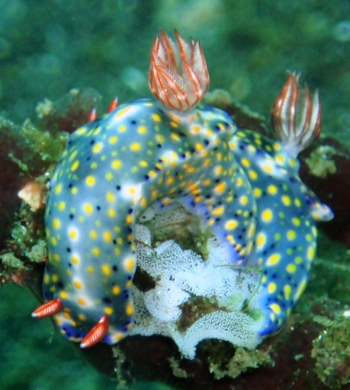
Dear Bill
I thought you might find these pictures interesting. I struggling telling the difference between Hypselodoris infucata and H. kanga but I'm guessing these to be H. kanga.
Locality: Dive Site - Jahir 2 in Lembeh Strait, 40 ft, North Sulawesi, Indonesia, Molucca Sea, 01 July 2007, Sandy bottom. Length: 3 cm. Photographer: Mike Krampf.
Cheers,
Mike
mtkrampf@yahoo.com
Krampf, M., 2007 (Jul 28) Hypselodoris kanga laying eggs in Lembeh. [Message in] Sea Slug Forum. Australian Museum, Sydney. Available from http://www.seaslugforum.net/find/20163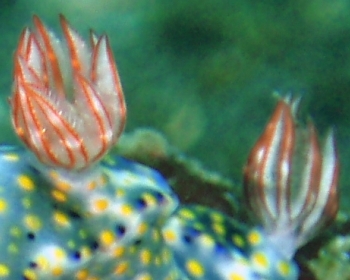
Dear Mike,
The easiest external distinguishing character between these two species is the shape and colour of the gills. If you can imagine a cross-section through one of the gills in this photo it would be a triangle, which means that each gill has a flat outer edge, and gill leaflets down each side. Hypselodoris kanga has gills like this. On the other hand, in H. infucata, the gills have only two sides, each lined with leaflets, so in cross-section it would be a single plane. In both species the edges are lines with red or orange, so in H. infucata there is a single red line up the inside and a single red line up the outside edge. In H. kanga, there is a single red line up the inside edge, and a red line up the two outside edges. Usually the space between the two outside red lines contains a row of white or yellow spots which makes the difference between the two species very obvious.
As luck would have it, your animals don't show the spots very well but I assume the few white spots we can see are all that are present in these animals. The spots are possibly defensive glands, so they could recently have has their contents expelled.
Best wishes,
Bill Rudman
Re: Hypselodoris kanga feeding
May 14, 2007
From: Richard Swann
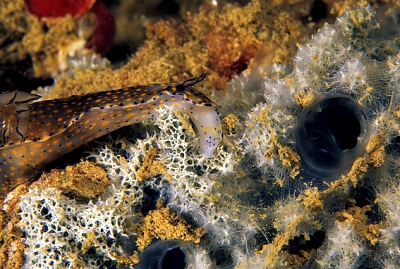
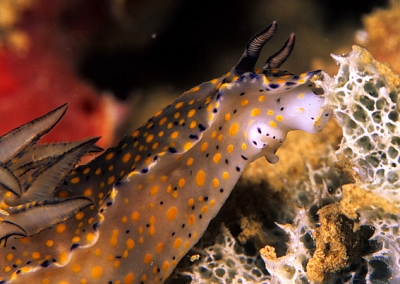
Concerning message #19895:
Hi again Bill
I am glad my shots have been of interest - I must confess when I pushed the shutter I thought Bill will like these !!
I have attached a couple more I took at the same time in case you can get any more info from them. For your information there were four H. kanga feeding on the same sponge that day - they were really ripping chunks off aggressively as if they felt the need to compete.
Best regards
Richard
richard@downbelow.co.uk
Swann, R., 2007 (May 14) Re: Hypselodoris kanga feeding. [Message in] Sea Slug Forum. Australian Museum, Sydney. Available from http://www.seaslugforum.net/find/19897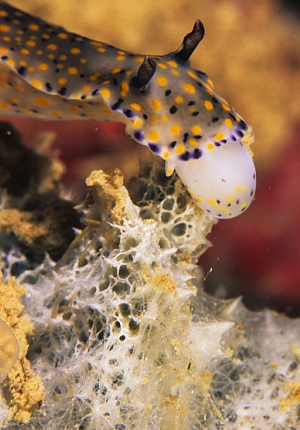
Thanks Richard,
If anyone asks about Hyspselodoris feeding I will be able to refer them to your two messages. The upper photo in this set is particularly good at showing what a Dysidea colony looks like before and after a feeding attack by Hypselodoris.
Best wishes,
Bill Rudman
Hypselodoris kanga feeding
May 10, 2007
From: Richard Swann

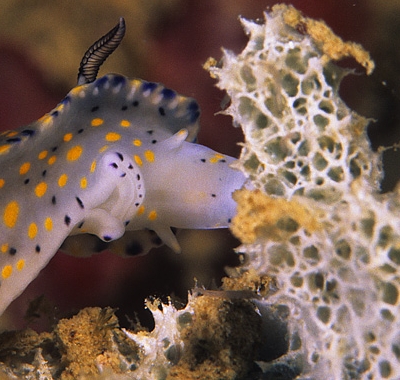
Hi Bill
I was reading Mike's post [#18901 ] and thought I would share a few images I took recently.
They display the yellow spots on the gills that you describe on Hypselodoris kanga and also a few close ups of H. kanga feeding.
Locality: Mamutik island,Kota Kinabalu, 11meters, Sabah, Borneo, South China Sea, 04 May 2007, sheltered reef. Length: 25mm. Photographer: Richard Swann.
I hope you find them an interesting addition to the forum.
Best regards
Richard
richard@downbelow.co.uk
Swann, R., 2007 (May 10) Hypselodoris kanga feeding. [Message in] Sea Slug Forum. Australian Museum, Sydney. Available from http://www.seaslugforum.net/find/19895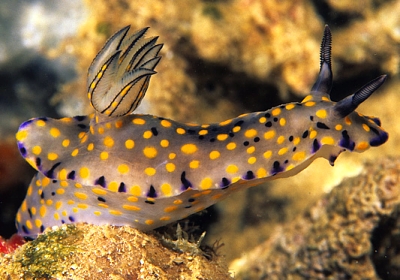
Dear Richard,
These are a wonderful addition not only to the Forum but also to our knowledge of the biology of these animals. We have a number of records of H. kanga feeding, and all of them are on this species of Dysidea. However none of them show the oral tube extended as well as this and none of them show the structure of the sponge skeleton as well as this. The sponges eaten by chromodorids lack the mineral skeleton of spicules found in most sponges and so looking for spicules in their stomach contents is a waste of time. In fact it is more than a waste of time and can be very misleading because loose siliceous sponge spicules from dead sponges are very common on the sea floor and are often incorporated in growing colonies of other organisms, or contaminate food as it is eaten. For example it is not unusual to find sponge spicules in the stomach of herbivores who swallow them with theri algal food.
The skeleton of these non-spiculate sponges consists mainly of bundles of fibres which are arranged in a network framework. The classification of these sponges is partially determined by the way these fibres are arranged and how diiferent arrangements are found in different parts of the sponge colony. So your Hypselodoris has done the sponge experts job by cleaning off the soft tissue from around the fibre bundles, so we can confirm its identity.
Best wishes,
Bill Rudman
Hypselodoris kanga feeding - Thailand
March 6, 2007
From: spencer finn
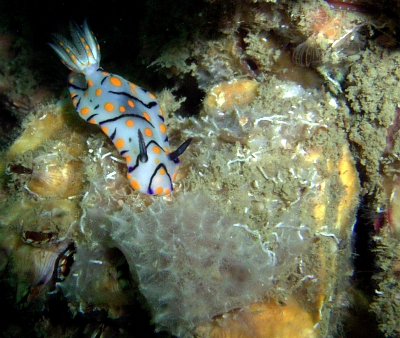
Hi there, great site, loadsa useful info.
Was hoping someone could help me identify this little critter. A nudibranch of some sort I have not seen before.
Locality: Phuket, 25 m, Thailand, Andaman Sea, 22 February 2007, wreck. Length: 3 cm. Photographer: Spencer Finn.
Spencer Finn
spencerfinn@yahoo.co.uk

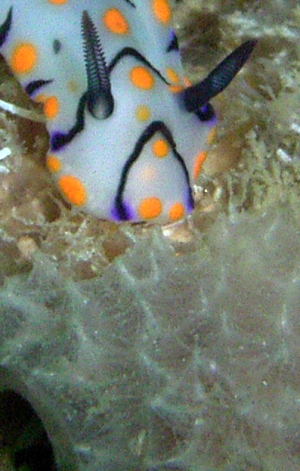
Dear Spence,
Glad you like the Forum. One of the great features of the Forum is how interested non specialists can give us valuable information. For example, your photo shows this nudibranch feeding on a species of the sponge genus Dysidea. We know little about feeding specialisation in nudibranchs so every little new bit of information like this helps us to build up the 'full' picture. Your animal is Hypselodoris kanga, which can usually be identified from similarly coloured species by the yellow spots down the outside face of each gill. For example, this colour form is similar in colour to H. zebrina but it has quite differently coloured gills.
Best wishes,
Bill Rudman
Hypselodoris kanga from Lembeh St, Indonesia
January 11, 2006
From: Ken Tucker

Hi Bill,
Here ia another one I have not been able to match to either SS database or any other reference material. Can you suggest?
Locality: Reef, Indonesia, Lembeh Strait. Depth: perhaps 30-40 ft. 5 November 2005. Photographer: Ken Tucker
Ken Tucker
ken@kilili.com
Tucker, K.C, 2006 (Jan 11) Hypselodoris kanga from Lembeh St, Indonesia. [Message in] Sea Slug Forum. Australian Museum, Sydney. Available from http://www.seaslugforum.net/find/15520
Dear Ken,
This is Hypselodoris kanga feeding on a species of Dysidea. Although it looks very like H. infucata, if you look closely at the gills you can see they are triangular in cross-section and have a series of spots down the outer edge of each gill.
Best wishes,
Bill Rudman
Hypselodoris kanga from Bali
December 13, 2005
From: Erwin Kodiat
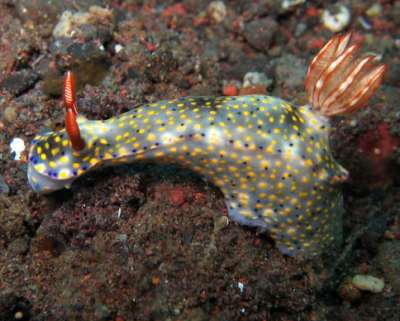
Hi Bill,
Actually I'm not so sure if it is H. obscura or H. infucata. Can you help me ID this?
Locality: Seraya, Bali, Indonesia. Lombok Strait. Depth: 12 meters. Length: 50 mm. 20 November 2005. Rocky. Photographer: Erwin Kodiat
Thanks,
Erwin Kodiat
ungu@terong.com
Kodiat, E., 2005 (Dec 13) Hypselodoris kanga from Bali. [Message in] Sea Slug Forum. Australian Museum, Sydney. Available from http://www.seaslugforum.net/find/15444Dear Erwin,
I am afraid it is neither of those species. It does belong to this group of similarly colored species, but H. obscura is only found in south- eastern Australia, which counts it out, and the wide-spread H. infucata has simple gills
This is an 'all spotted' form of Hypselodoris kanga [see message #8722]. I have discussed the difference between it and H. infucata in an earlier message [#14188]. Sometimes H. kanga can have dark blue diagonal lines on the mantle while at other times it can have dark blue spots. Its most distinguishing feature is the shape and colour of the gills, which are triangular in cross-section, and have a series of yellow (or cream) spots on the smooth outside face of each gill. The three edges of each gill are lined with blue (basally) and red (apically) although in different animals one or the other of these colours can dominate.
In your photo, the swollen oral tube can be seen protruding from the mouth, a sure sign that it is feeding. Unfortunately I can't see any sign of its sponge food, but I guess it has found a small colony of Dysidea, the only sponge it is known to eat.
Best wishes,
Bill Rudman
Hypselodoris kanga from Indonesia
July 4, 2005
From: Bill Rudman
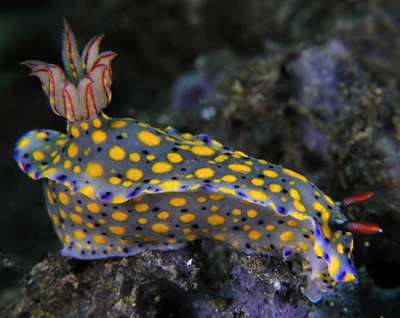

For cross-reference, I separated this photo from Bob Whorton's message [#14188] as that message includes two very similarly coloured species.
Locality: Jahir dive site, Sulawesi, Lembeh Strait, Indonesia. Depth: 12 m. Length: 6 cm. September 2004, Black Sand. Photographer: Bob Whorton
This is Hypselodoris kanga. One way to distinguish it from H. infucata is the colour and shape of the gills. In H. kanga the gills are triangular in cross-section and the three edges are lined in red, although this can chnage to dark blue towards the base in some animals. There also yellow spots down the oute face of each gill, and sometimes down the inside edge as well. In H. infucata the gills are simple, and the innner and outer edges are lined with red, but there are never yellow spots.
Bill Rudman
Hypselodoris kanga from The Philippines
May 3, 2005
From: Paul Osmond

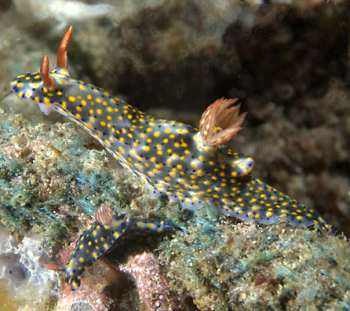
Bill,
Here is a pair of Hypselodoris infucata on some artifical reef structures on the house reef of the Exotic Dive Resort on the island of Malapasuca in The Philippines.
There was actually 4 of this species on this area, but these two were closest together and much easier to photograph. As you can see the larger one is 3 times the size of the smaller one.
There appeared to be plenty of feeding activity in the area, but no mating behaviour was observed.
Locality: Artifical Reef, Malapascua Island, Cebu, The Philippines. Depth: 8 m. Length: 40 mm, 15 mm. 03 Dec 2004. Sand bottom, artificial structures. Photographer: Paul Osmond
Yours,
Paul
Deep Sea Images
www.deepseaimages.com
marriard@deepseaimages.com
Osmond, P.T., 2005 (May 3) Hypselodoris kanga from The Philippines. [Message in] Sea Slug Forum. Australian Museum, Sydney. Available from http://www.seaslugforum.net/find/13688Dear Paul,
This is the very similarly coloured Hyspelodoris kanga. Sometimes the blue marks in this species are lines, and in other animals they are spots. The easiest way to separate them is that the gills in H. kanga are triangular in cross-section, and the outer face has a series of yellow spots. In H. infucata the gills are 'simple' - two-sided, with gill lamellae on each side - with a red line down each edge.
Best wishes,
Bill Rudman
Hypselodoris kanga - juveniles from Sulawesi?
December 2, 2003
From: Francis & Pirjo Pellet
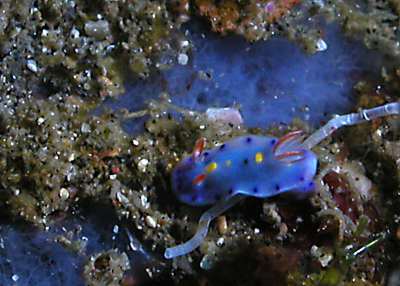
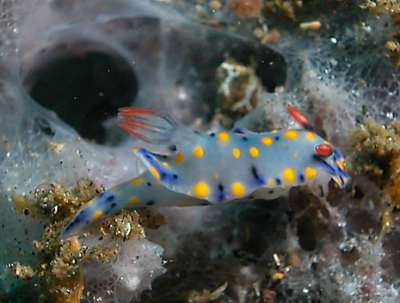
Dear Bill,
Are the upper two photos juvenile forms of Hypselodoris infucata ?
Photos: Upper - length 10 mm; Middle - length 15mm; Lower - length 30 mm.
Dive site : Police Pier Lembeh Straits, North Sulawesi
depth: 18 m
30 September 2003
Thanks
Francis & Pirjo
pirjo.pellet@pellet.fr
Pellet, F & Pellet, P., 2003 (Dec 2) Hypselodoris kanga - juveniles from Sulawesi?. [Message in] Sea Slug Forum. Australian Museum, Sydney. Available from http://www.seaslugforum.net/find/11559
Dear Francis & Pirjo,
Thanks for these photos of juveniles. They ceratinly have similalrities to H. infucata but I am pretty sure they are Hypselodoris kanga. One of the key differences is that in H. kanga the gills are triangular in cross section with a coloured line up the three corners, and a series of yellow spots on the ouside flat edge of each gill. Your photos show a nice series showing the development of this character. In the smallest animal [uppermost photo] the gills are not yet triangular in cross section but there is a coloured line up the upper and lower edges. In the middle photo the outer gills face has widened and has a coloured line along each edge. In the largest animal [lower photo] the spots are beginning to appear.
Best wishes
Bill Rudman
Hypselodoris kanga from Indonesia
July 11, 2003
From: Danny Van Belle

Here some nice pics of Hypselodoris obscura or H. kanga?
Filmed at Lembeh Strait at 3m depth, April 2002. North Sulawesi, Indonesia
Best regards,
Danny Van Belle
dannyvb@hotmail.com

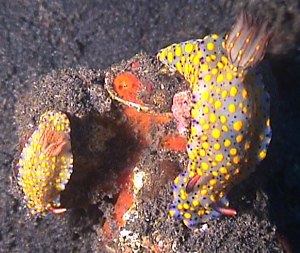
Dear Danny,
Thanks for these photos. This is Hypselodoris kanga. The yellow spots on the outside face of the gills is a unique character of this species. I suspect the sandy looking object these animals are on is one of those sponges which incorporates sand grains into its 'skeleton'.
Best wishes,
Bill Rudman
Boon sung & Bang sak - Thai place names
March 21, 2003
From: Danny Van Belle
Hi Bill,
Just to inform you that the wreck were Mary Jane shot the Hypselodoris kanga is the same as the one I call Boon Sung. There are many liveaboards around the Similan Ids all leaving from Taplamu near Kao Lak. However different boats use many different names for the same divesites. As you'll notice Boonsung and Bang sak do not sound so different !
Typical thai style !
Best regards
Danny Van Belle
dannyvb@hotmail.com
Thanks Danny,
I had noted the similarity and wondered whether they were the same wreck. Now that we have all the names - and spellings - in one message, I guess anyone looking for one of them will have a cross-reference. I did a quick websearch and found the most used spellings were Boonsung and Bang sak. The other interesting thing I discovered was that the boat was built right here in Sydney, Australia in 1927.
Cheers,
Bill Rudman
Hypselodoris kanga feeding
March 19, 2003
From: Mary Jane Adams
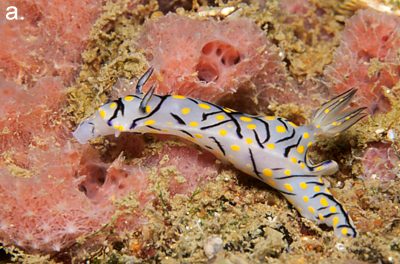

Hi Bill,
I photographed the attached images of Hypselodoris kanga on the Bang Sak wreck near Khao Lak, Thailand. This divesite is on the west (Andaman Sea) coast of Thailand. The depth was 12 to 15 meters.
Image A was photographed on Feb. 18, 2003 and images B and C on March 1, 2003. They were all feeding on sponges that appeared gray at this depth, but were really pink when illuminated. Much of the sponge growth on top of this wreck was covered with silt and debris, but I did find places where enough was exposed to show the structure [A].
The pair in B stayed close together all afternoon while ripping chunks off the sponge.
The pair in C were about half a meter away. Note the bifid left rhinophore in the larger one. All the H. kanga I saw on this wreck were 15-20mm long. This is only about half the length of the all-over-spotted ones I photographed in Lembeh Strait, Sulawesi, Indonesia. [see previous messages]
Best regards,
Mary Jane
divepng@yahoo.com
Adams, M.J., 2003 (Mar 19) Hypselodoris kanga feeding. [Message in] Sea Slug Forum. Australian Museum, Sydney. Available from http://www.seaslugforum.net/find/9417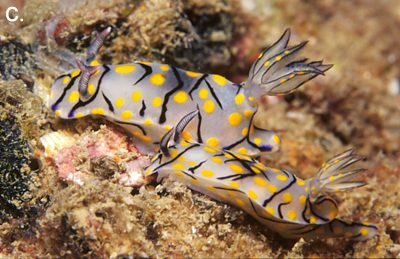
Dear Mary Jane,
Thanks for these images. By wonderful co-incidence your message arrived the day I posted Danny Van Belle's photos of specimens of H. kanga clustered around small colonies of the same sponge. I think we can be pretty sure this is its favourite food - at least in Thailand.
Best wishes,
Bill Rudman
Hypselodoris kanga - feeding observation
March 14, 2003
From: Danny Van Belle
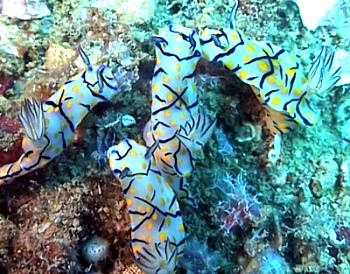
Hi Bill,
Here 4 Hypselodoris kanga together at the Boonsung wreck - Taplamu - Thailand.
Depth 12m on top of the wreck.
Sorry for the poor quality as I had to be quick just at the end of the dive.
Best regards
Danny
dannyvb@hotmail.com
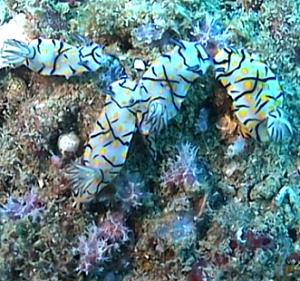
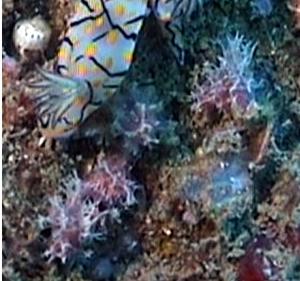
Thanks Danny,
These are a great addition to your earlier photos as they clearly show these animals are congregating and feeding on the greyish purple sponge which as I suggested earlier could be a species of Dysidea, and hopefully can be identified by an expert from the photos alone.
Hypselodoris kanga from Singapore
January 30, 2003
From: Ria Tan
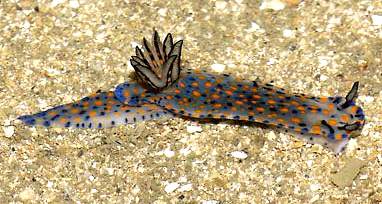
Dear Dr Rudman,
Firstly, I must say how wonderful I think your site is. It provides so much information and such stunning photos of these delightful creatures. My name is Ria Tan from Singapore and I am a volunteer nature guide at Chek Jawa, an intertidal flat that was nearly lost to reclamation.
Fortunately, the government decided to defer reclamation for 10 years after widespread appeals from the public to preserve this unique habitat. For more information on Chek Jawa, do visit http://chekjawa.nus.edu.sg.
Since the deferment, I and other volunteers have been working hard to produce a guidebook for visitors to Chek Jawa. Hopefully you will be able to help us identify some of the beautiful slugs that we commonly find on Chek Jawa. These IDs will then be included in our book so the children will have a better understanding of these creatures. In this way, we can work towards preserving Chek Jawa forever. If you could help me with the IDs, I would be most grateful. Any interesting information on each of these creatures would also help the kids feel a stronger connection to them and to the need to preserve Chek Jawa.
All these creatures were found on the intertidal zone that is exposed at low spring tide. Photo: Alan Yeo
Looking forward to a reply.
Thank you!
Ria.
tanria@singnet.com.sg
Tan, R., 2003 (Jan 30) Hypselodoris kanga from Singapore. [Message in] Sea Slug Forum. Australian Museum, Sydney. Available from http://www.seaslugforum.net/find/9035Dear Ria,
I am happy to help your project. In return we get some interesting infpormation on the sea slug fauna of Singapore. This beautiful animal is Hypselodoris kanga, one of a large family [Chromodorididae] of colourful sponge-feeding nudibranchs. This species has been found from east Africa across to Malayisa and Papua New Guinea. If you look at the ther messages on this page you will see it has some variability in colour, but in all cases it has the characteristic yellow spots on the gills. I first found this species in Tanzania, and its species name 'kanga' is from the name of the colourful cotton cloth, used by the women in East Africa, for clothing.
Best wishes,
Bill Rudman
Hypselodoris kanga from Sulawesi
January 3, 2003
From: Mary Jane Adams

Hi Bill,
Here is another Hypselodoris kanga from Lembeh Strait, Sulawesi Island, Indonesia. It certainly has a variable pattern of spots and lines. Even the rhinophore color is variable. It seems like each individual is custom designed. The only way I can distinguish it from H. infucata is from the yellow-spotted gills. This one is checking out a purple sponge.
Divesite: Tekat Larry,
Length: about 3-4cm,
Depth: about 10 meters, Nov. 22, 2002.
Best regards,
Mary Jane
divepng@yahoo.com
Adams, M.J., 2003 (Jan 3) Hypselodoris kanga from Sulawesi. [Message in] Sea Slug Forum. Australian Museum, Sydney. Available from http://www.seaslugforum.net/find/8722Dear Mary Jane,
Thanks for this photo which, as you say, shows the yellow spots on the gills very clearly. One constant difference from H. infucata is that the gills in H. kanga are triangular in cross section, which is why there is a smooth outer face on which the yellow spotted colour pattern can exist. The gills in H. infucata on the other hand are what we call 'simple'. They consist of a single plane, with lamellae on each side, the inner and outer edges being quite thin. You are right in thinking this species is rather variable in colour, especially since I've included Danny Van Belle's animals from Thailand, but there seems to be a continuum in the variability of the colour pattern. The background colour can range from dark translucent blue to white, the dark blue spots can become lines, and the rhinophores and gills can lack the orange-red colouration. But these differences seem to vary independently of each other so there is no way we could define 'subspecies' or 'colour morphs.'
Best wishes,
Bill Rudman
Hypselodoris kanga from Thailand
December 18, 2002
From: Danny Van Belle
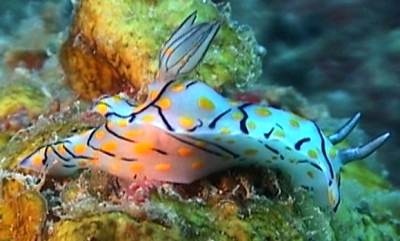
Hi Bill,
To accompany my other message. Are these Hypselodoris zebrina or Hypselodoris kanga or Hypselodoris infucata!!! All filmed at Boonsung wreck, Taplamu, Thailand. Depth between 12m to 20m
Best regards
Danny
dannyvb@hotmail.com



Thanks Danny,
These are a very useful comparison to your your photos of Hypselodoris zebrina from the same location. I have been indentifying this animal as Hypselodoris kanga althpough the colour of its rhinophores are blue rather than red. Interestingly all the specimens I have seen from the northeastern Indian Ocean and and the contiguous nortwestern Pacific [Hong Kong] have blue rather than red rhinophores. The other interesting feature is the prominent development of bluish purple lines in your animals and almost total loss of blue spots. It is early days, but I would not be surprised if these regional differences were the result of H. kanga mimicking different similarly coloured species in different geographic regions. For example, perhaps in the northeastern Indian Ocean it is mimicking Hypselodoris zebrina. What all colour forms of H. kanga have in common are the yellow spots on the outer face of each gill. It differs from H. zebrina in having gills which are triangular in cross section, each outer edge being lined in bluish purple. One of your photos shows an animal amongst a few patches of a greyish sponge which looks very like a species of Dysidea, which could well be its food sponge.
Best wishes,
Bill Rudman
Hypselodoris kanga from Sulawesi
July 12, 2002
From: Mary Jane Adams
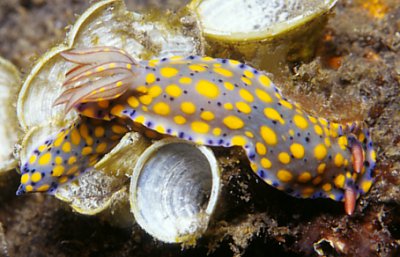

Hi Bill,
What do you think this is? Crawling length was about 4 cm. I found it at 15 meters on black sand. Divesite: Teluk Kembahu, Lembeh
Strait, Sulawesi, Indonesia. April 18, 2002.
Best regards,
Mary Jane
divepng@yahoo.com
Adams, M., 2002 (Jul 12) Hypselodoris kanga from Sulawesi. [Message in] Sea Slug Forum. Australian Museum, Sydney. Available from http://www.seaslugforum.net/find/6849Dear Mary Jane,
This is Hypselodoris kanga. Previously known from the western Indian Ocean we now have records from the eastern Indian ocean and Western Pacific. The yellow spots on the outer face of the triangular (in cross-section) gills, is a characteristic of this species.
Best wishes,
Bill Rudman
Hypselodoris kanga from Papua New Guinea
December 13, 2001
From: Tim Murrell


Dear Dr Rudman,
Here is another nudibranch that I pulled of the film from Loloata Island, Port Moresby, Papua New Guinea.
The photos were taken in 1m of water at low tide in sea grass beds. Early June 2001.
The animal is quite small as you can see from the rather large thumb in the images.
Would you mind providing an Id for this animal?
Tim Murrell
maxx@bigpond.net.au
Murrell, T., 2001 (Dec 13) Hypselodoris kanga from Papua New Guinea. [Message in] Sea Slug Forum. Australian Museum, Sydney. Available from http://www.seaslugforum.net/find/5819Dear Tim,
This is Hypselodoris kanga. As I discuss at the top of the page this is one of a number of similarly coloured species. It can be distingusihed by the row of yellow spots up the outside face of the triangular shaped gills. Unfortunately this is the one character I can't see in your photos, but the gills do appear to be triangular and the reddish tip is also a useful character.
Best wishes,
Bill Rudman
Hypselodoris kanga from Hong Kong
July 16, 2001
From: Leslie Chan

Dear Bill,
Could you identify this nudibranch which I photographed in Hong Kong.
Details: 8m, Ping Chau, Hong Kong. 31 January 2001.
Thanks
Leslie Chan
leslie@lesmart.com
Chan, L., 2001 (Jul 16) Hypselodoris kanga from Hong Kong. [Message in] Sea Slug Forum. Australian Museum, Sydney. Available from http://www.seaslugforum.net/find/4767Dear Leslie,
This is Hypselodoris kanga.
Best wishes,
Bill Rudman
Hypselodoris kanga from Hong Kong
July 16, 2001
From: Bill Rudman & Brian Darvell
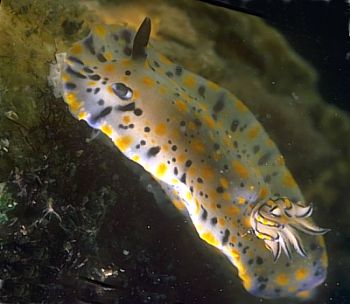
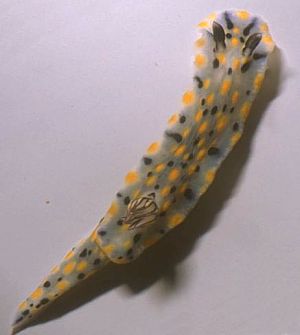
Here is some information and photos on Hypselodoris kanga from Brian Darvell's Hong Kong collections to accompany Leslie Chan's photo.
PHOTO: UPPER: S.Lamma Is, Shum Wan, Hong Kong, 28 Feb 1987 AM C153329. On sponge, Photo: Brian Darvell. LOWER: Hong Kong, April 1983. Photo: B.E Picton.
This is one of a group of similarly coloured species of Hypselodoris which have a bluish background colour and dark blue and yellow spots. Specimens from Hong Kong have a very pale blue or white background colour whereas east African specimens of the same species are a darker blue. The most characteristic feature of H. kanga is that there is a series of bright yellow spots up the outer face of each triangular gill. Each gill is edged in blue. It grows to 40 mm. Of particular interest is the sponge that Brian Darvell has photographed feeding on. I am not sure of its name but it is a dull khaki yellow with a skeleton of dark purple-black fibres. The same, or a very similar sponge has been recorded in eastern Australia as the food of Chromodoris collingwoodi.
Hong Kong Collection Records:
AM C137067, 3 specimens, 14 November 1982, Site 2.32, Round Is. (E), Mirs Bay, 7-12 m. AM C140153, I May 1983, Site 8.38, Long Ke Wan (NE side), 6 m. AM C153328, 14 September 1986, Site 8.175, Kei Kok Tau, nr. Tai Long Wan, 6 m. AM C153329, 28 February 1987, Site 13.96, Shum Wan (W), Lamma Is., 6 m. Depth range: 0-12 m.
Reference:
• Rudman, W.B. & Darvell, B.W. (1990) Opisthobranch molluscs of Hong Kong. Part 1. Goniodorididae, Onchidorididae, Triophidae, Gymnodorididae, Chromodorididae, (Nudibranchia). Asian Marine Biology, 7: 31-79
Best wishes,
Bill Rudman & Brian Darvell
Hypselodoris kanga from NW Australia
May 4, 1999
From: Clay Bryce

Dear Bill,
Here is another species from northwestern Australia. It is from the East side of Bernier I., Shark Bay. H. infucata (again!)WAM568-91. A lot darker than the others and seems different to the other dark H. infucata (specimens that I was calling H. obscura)we get over here. Or is this H. obscura (dark form)?
Clay Bryce,
W.A. Museum
Perth.
brycec@museum.wa.gov.au
Bryce, C., 1999 (May 4) Hypselodoris kanga from NW Australia. [Message in] Sea Slug Forum. Australian Museum, Sydney. Available from http://www.seaslugforum.net/find/834Dear Clay,
This is Hypselodoris kanga. A bit dark, but the tell-tale gills, triangular in cross-section, with yellowish spots down the outer (non-lamellate) face, are clearly visible in your photo. Probably a new record for Western Australia?
Bill Rudman.
Hypselodoris kanga from the Philippines
April 23, 1999
From: Erwin Koehler
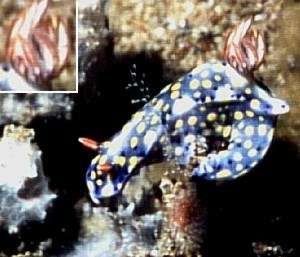
Bill,
one more photo by Klaus Stark-
email: K.Stark@t-online.de
It was taken at:
Philippines, Negros Is., Dauin, 26m depth, March 1999, size 27mm.
I think it is Hypselodoris infucata or H. obscura.
Thanks
Erwin
Medslugs.Koehler@t-online
Koehler, E., 1999 (Apr 23) Hypselodoris kanga from the Philippines. [Message in] Sea Slug Forum. Australian Museum, Sydney. Available from http://www.seaslugforum.net/find/800Dear Erwin,
It is in fact Hypselodoris kanga which, from the photos on the Forum, is turning out to be quite variable in colour. One good character is the shape of the gills and their colour. If you cut through a gill it is triangular in cross-section, the outer 'side' being smooth, not lamellate, and with a pattern of white or yellow oval spots.
Best wishes,
Bill Rudman.
Hypselodoris kanga from Indonesia
March 5, 1999
From: Michael Miller
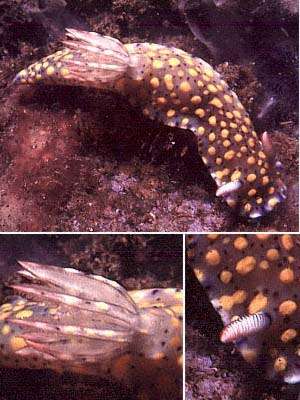
Dear Bill
Continuing the Hypselodoris thread , you will find attached two images
believed to be Hypselodoris kanga and H. nigrostriata. Both images recorded at Tulamben, Bali, Indonesia in Oct. of last year.
Cheers;
Mike
mdmiller@cts.com
Miller, M.D., 1999 (Mar 5) Hypselodoris kanga from Indonesia. [Message in] Sea Slug Forum. Australian Museum, Sydney. Available from http://www.seaslugforum.net/find/639Thanks Mike,
I've put the H. nigrostriata picture on the appropriate page.
I have added magnified insets of the gills and rhinophores to show characteristic colour patterns. I would agree with your identifications.
Cheers,
Bill Rudman.
